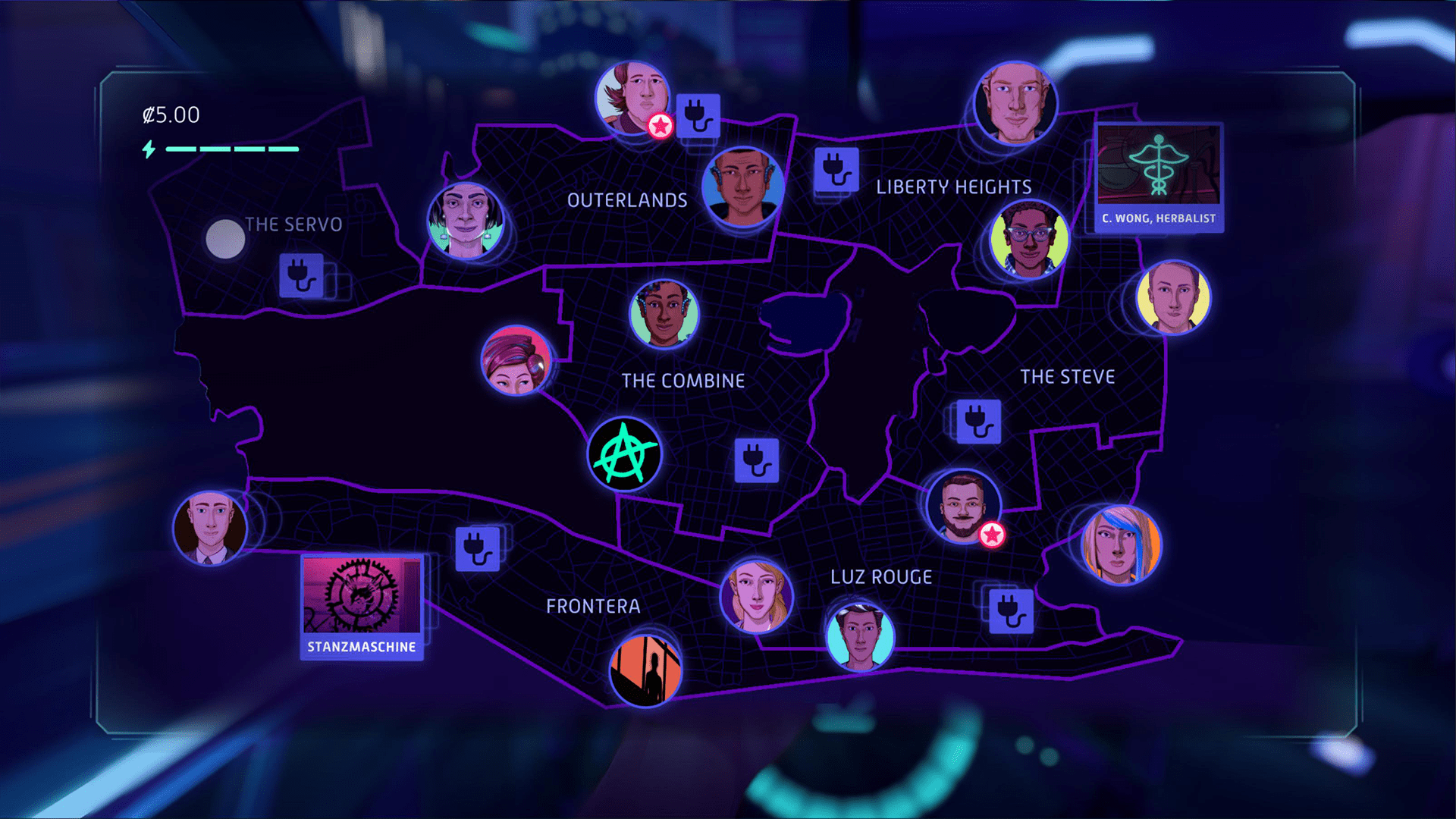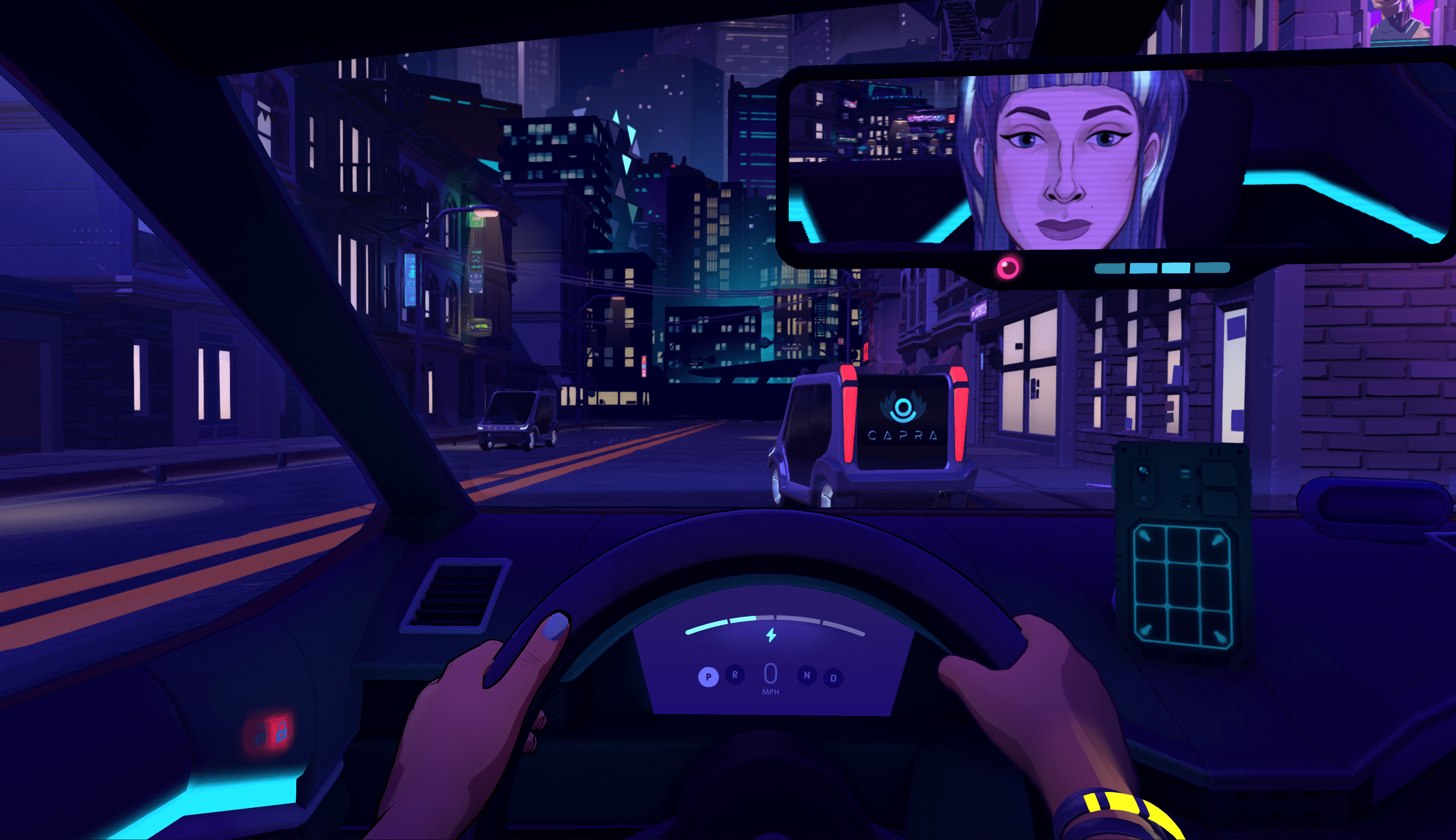The world is moving faster and growing exponentially. Technology is being built to make every facet of our lives more convenient, efficient, and just better. As applications and services expand, it is possible, as we stare at our computer screens and digital devices, that slowly but surely, we are unknowingly weathering away our humanity. As corporations and companies grow stronger and more powerful, the worst of misdeeds can happen in the darkest of corners. Neo Cab is a game about staying human. In the face of new and upcoming technology, the biggest challenge isn’t to find your friend, or overthrow an evil-doing entity, but most importantly, to use your feelings in the struggle to stay human.
Lina Romero moves to Los Ojos, a brand new city in the desert. She leaves Cactus Flats to begin a new life in the desert with her best friend, Savy. Lina loves her job as a driver for the ride-sharing company, Neo Cab. Along the way, she picks up her first guest as a Neo Cab driver, Liam. A short trip and discussion later, Lina finds herself in the high-tech city of Los Ojos, powered by applications, technology, but regrettably her former employer, a rival ride-sharing company called Capra. Upon discovering the corporate wrongdoings and violation of workers’ rights in the workplace, Lina resigned from Capra. Since then, she’s had her guard up in regards to technology, especially as technology becomes woven further into everyday life and increases the risk of invading privacy without consent. Despite this, her best friend Savy gives her a Feelgrid, a special device on her wrist that measures emotions and feelings, all changing to corresponding colors. Shortly after this, Savy disappears mysteriously. Confused, frightened, and with no place to live, Lina’s move to Los Ojos is anything but normal. Lina discovers Capra yields a huge presence in Los Ojos, reigning control of much of the city, including government officials. Law enforcement is backed by Capra as well. An anti-Capra resistance has formed, sabotaging and damaging Capra vehicles and utilities. With a major change to the government looming, Lina grows suspicion that Savy’s mysterious disappearance is no coincidence to the rise of Capra in the city. Further complicating this matter, Capra is trying to put her out of a job, as she is employed by Neo Cab and Capra, as a competitor, seeks to completely defeat Neo Cab. Lina delves deep into the city of Los Ojos, picking up passengers along the way, in a mission to find her friend and potentially undo a corporate conspiracy.
Neo Cab has players star as Lina Romero. She is not a soldier. She has no genetic mutations or special powers. She has no cybernetic augmentations or prior training. She is a regular rideshare driver for NeoCab. Unable to call the cops to find her best friend, she is only armed with her mind, along with her fears, insecurities, and aggression. In Neo Cab, the feeling is absolutely everything. The Feelgrid on Lina’s wrist adjusts to different colors, with each color corresponding to specific emotions. Red is anger, blue is cold, mauve is emotional, yellow and green is happy or content. These feelings are important as Lina’s mood will be affected by a manner of instances. Helping other people may bring happiness or contentment to Lina, but discussions about Capra, while necessary, may bring about anger. These feelings can open new dialogue options or shoot others down, depending on the situation. Through interacting with various passengers, Lina will discover clues to Capra, the whereabouts of her friend, and perhaps, even more about herself.
Neo Cab has an assortment of strengths, gelling and weaving with a smart and intellectual narrative that intersects and interacts with various other arcs. This begins with Lina, the protagonist. She is just an everyday person, looking for a new life. She can hold her own in a corner and is talkative, but she’s always in a constant swirl of feelings. These feelings will be in constant flux as new passengers enter Lina’s car and share their stories. A first date, an underground doctor, a tourist, a quantum statistician are just some of the passengers that enter Lina’s car. Lina becomes an arbiter, and how she interacts, reacts, and proactively engages in conversation leads Lina on her quest to find Savy, but also gives clarity to passengers. In these conversations, various themes are written beneath the surface of most conversations. This is where Neo Cab excels.
When Lina receives the Feelgrid, emotions become everything. All feelings are valid in Neo Cab. In Neo Cab, the choice is not to choose the best response but to choose what is best felt. It’s an interesting mixture of conflict and relatability. There is a conflict between what the player feels and what the player wants Lina to feel. In Neo Cab, feelings can open doors and close them. Feelings can open responses and deny responses as well. It completely depends on the choice of dialogue taken. Naturally, as with all things, players cannot control the consequences of what is said and how these feelings change. Mentioning Capra makes Lina angry. Thinking of Savy makes Lina sad, happy, or content. These interactions and conversations change even further depending on the passenger which includes the themes of certain discussions. The nature of these discussions will affect Lina, how much coin she earns, and her overall rating, in which she needs to maintain four stars or above before she is terminated by Neo Cab. Finally, in addition to maintaining ratings and pay, the choices made, especially during several key moments, will influence one of three of the game’s endings. This approach is remarkably original and refreshing. Most games in this genre contend with different subject matters in more familiar settings, but for Neo Cab the writing and story go a step further with connecting the fictional world of the game to the realities of the real world we live in today.
Underlying in every conversation are topics of technology and how that interfaces with humans, for better and for worse. In Neo Cab, in a world powered by applications and technology, it’s clear the development team brings about those themes to encourage discussion. The themes of big technology, the abuses of companies and corporations, and their influence on basic services such as law enforcement and lodging are all notable themes. Perhaps, the most important theme is the focus on authenticity or realness. Does an application make the ability to find another human authentic or inauthentic? Is it real humanity and chance or an array of numbers and codes at the behest of a larger company? Even further, if you knew what you were feeling, does it help determine your choices with more clarity or at the control of the device? These questions are further emphasized as vulnerability is exposed, and can it easily become an advantage but also a trait that can be taken advantage of by others. Putting feelings out there can have a backfiring effect. Empathy can dismiss reason and anger is a great defense, given the moment.
 With a solid presentation, Neo Cab perfectly settles in that atmosphere of a late-night drive, where feelings, thoughts, and emotions, all tend to be stronger. The ambient, soothing music and the large degrees of purples and blues make Neo Cab a visually distinctive game. Neo Cab introduces players to various characters, and while it is not necessary to interact with everyone to progress the story, diversity and representation are well-thought-out and appreciated. Coupled with the conversations and story arc, Neo Cab is worth the ride. However, there are several instances that hold Neo Cab back from greatness.
With a solid presentation, Neo Cab perfectly settles in that atmosphere of a late-night drive, where feelings, thoughts, and emotions, all tend to be stronger. The ambient, soothing music and the large degrees of purples and blues make Neo Cab a visually distinctive game. Neo Cab introduces players to various characters, and while it is not necessary to interact with everyone to progress the story, diversity and representation are well-thought-out and appreciated. Coupled with the conversations and story arc, Neo Cab is worth the ride. However, there are several instances that hold Neo Cab back from greatness.
Neo Cab presents its story as text. The persons change their facial expressions during the conversation and do feature unique effects, such as a passenger pulling up a holo-display in front of her face and lights woven into attire. However, there is no spoken dialogue in Neo Cab. While I perfectly understand that Neo Cab is built by a small indie team, I feel this hurts the narrative and story presented. Neo Cab has very good writing, but these characters have an emotional weight to them, and if they spoke, it would make the experience more memorable. Granted, hiring voice actors and actresses is expensive, and in the absence of that, writing, and how that is presented is essential. Additionally, Neo Cab gives the impression that Los Ojos is a large, lively city, but the city is never truly shown. The only real glimpses of Los Ojos we have are brief scenes, the attire of the passengers, and a few moments where Lina rests for the night in a hotel or apartment. Business, clubs, eateries, and other aspects of the city are never seen. It feels underwhelming, especially during several pivotal moments of the game, in which major events occur, and they are told through text instead of a cutscene or illustration. It’s unfortunate as I became so invested in these characters, and this world, that I had wished to see something more substantial during these moments that emphasize their emotional gravity and how they affect the leading characters. However, I once again reiterate that the story is strong, given the writing and direction. I just wish there was more impact in portraying the events. Finally, the Nintendo Switch version of Neo Cab needs optimization and improvement. The Switch version of Neo Cab does its job well enough, but framerate drops and an annoying “orange blob” glitch breaks the immersion. When a ride finishes, when Lina grabs her phone, an orange blob flashes briefly and distorts the screen.
Overall, I had a pleasant time with Neo Cab. This game is worth the ride with its style, writing, and distinctive story arcs in a subject matter that is almost exclusive to Neo Cab as most games in the genre fall to the areas of science fiction and fantasy. I would absolutely enjoy seeing Lina and these characters again in the future, in another game or another medium. Neo Cab presents a solid discussion and encourages conversation with ourselves and technology.
It’s what makes us, Human.
Find more information about Neo Cab on the official website. A digital Switch copy was purchased by the reviewer. For more unique indie game reviews, check out my thoughts on the quirky action game Super Crush KO or the cartoonishly violent Bloodroots.







